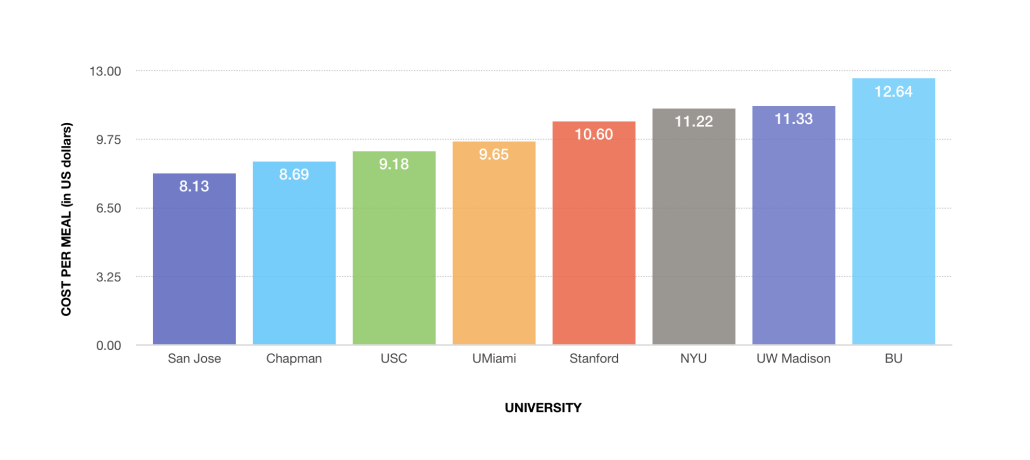Comparing USC’s meal plans to other universities

Without reliable transportation to pick up food and groceries and limited time to grocery shop, many students are reliant on University-provided meal plans in order to eat every day. For students such as Tyler Polarek, having a meal plan is “essential.”
“It allows for you to be able to grab something to eat in situations where getting food isn’t feasible,” said Polarek, a sophomore majoring in business administration and sociology. “I know when I’m running late and need to grab something, the meal plan helps me the most.”
All students living in USC Housing are required to purchase a meal plan, with freshmen living in first-year housing required to purchase the Cardinal Plan and upperclassmen living in on-campus apartments required to purchase the Apartment Plan at minimum.
This year, USC stopped allowing students to purchase an unlimited dining plan, instead offering students 19 meal-swipes a week.
Currently the main three meal plans at USC — the Cardinal Plan, Gold Plan and Trojan Plan — cost $3,315, $3,725 and $3,900 per semester, respectively. Compared to the University of Miami, Stanford University, New York University, the University of Wisconsin-Madison, Boston University, Chapman University and San José State University, USC has one of the most cost-effective meal plans and offers the third-lowest price per meal compared to these seven universities. These schools were selected for comparison as they each have some similar demographics to USC, including undergraduate enrollment, location and type of institution.
University of Southern California
USC is a private university in Los Angeles, Calif. with an undergraduate enrollment of 19,606 students in 2020.
The standard meal plan for students living on campus, the Cardinal Plan, costs $3,315 per semester and offers a total of 361 meal swipes, valuing each meal at $9.18. A meal swipe allows a student to purchase any meal from one of USC’s three dining halls and 11 additional USC Hospitality locations.
The Gold Plan, which is identical to the Cardinal Plan but with the addition of $500 Dining Dollars, costs $3,725. With this plan costing only $410 more that the Cardinal Plan, $90 worth of Dining Dollars are provided at no extra cost. Both the Cardinal and Gold Plans include seven guest swipes per semester. The Trojan Meal Plan is a full Dining Dollar Plan, with $3,900 Dining Dollars costing $3,900. Dining Dollars are bonus money added to a student’s ID card that allow students to buy meals at retail dining locations on campus.
In addition to these three plans, USC also offers plans to students who live in on-campus apartments or off-campus and aren’t eating every meal in the dining halls — the Apartment, Community 25 and Community 50 Plans. The Apartment Plan, which is only available to students living in USC Housing Apartments, includes 40 meal swipes and $150 Dining Dollars for $705, valuing each meal at $13.88.
“I think [the Apartment Plan is] OK, but I don’t think it’s a good rate of return,” Polarek said. “How do you get your money’s worth out of it?”
For Mary Ikeocha, a sophomore majoring in psychology who also has the Apartment Plan, her meal plan is “kind of worth it” because of the options outside of the three dining halls that her plan covers, such as the eateries at the Ronald Tutor Campus Center.
“[The Apartment Plan] is the least costly plan, so I guess it’s good that they have an option that’s not as expensive as the other ones,” she said. “I’m glad you can use it in other places that [aren’t] exactly the dining halls.”
USC does not currently offer an unlimited meal plan.
In a statement to the Daily Trojan, Executive Director of USC Hospitality and USC Hotel Dirk de Jong wrote that the University “constantly [evaluates] and [analyzes] traffic patterns and our data to ensure any changes to the plan reflects the needs and interests of our students.”
de Jong also added that meal plans offer students substantial discounts at retail venues when paying with a meal swipe as opposed to cash.
“The [swipes included in the Cardinal Plan represent] significant savings for each meal, since the cash equivalent for breakfast, lunch and dinner in the residential dining halls is significantly higher, as well as providing savings with the meal swipe combos offered in the retail venues,” de Jong wrote. “With 19 meals per week, the Cardinal Plan is very similar to an unlimited meal plan, with the additional flexibility of being able to use meal swipes in our retail venues.”
University of Miami
The University of Miami is a private university in Coral Gables, Fla. with an undergraduate enrollment of 11,334 students in 2020.
The 19-Week meal plan costs $3,400 a semester and includes 19 meals a week over an 18 week semester and $100 Dining Dollars, valuing each meal at $9.65.
The 14-Week meal plan costs $3,142 a semester and includes 14 meals a week and $150 Dining Dollars, valuing each meal at $11.87. The University of Miami also includes two block plans, the 175 Block and the 100 Block. The 175 Block costs $2,763 and includes 175 meals a semester and $250 Dining Dollars, valuing each meal at $14.36. The 100 Block costs $2,267 and includes 100 meals a semester and $750 Dining Dollars, valuing each meal at $15.17.
The University of Miami also offers an unlimited meal plan which costs $3,693 per semester and includes $100 Dining Dollars.
Stanford University
Stanford University is a private university located in Palo Alto, Calif. with an undergraduate enrollment of 6,366 students in 2020.
The 19 Meal Plan costs $2,421 and includes 19 meal swipes per week over a 12-week quarter, valuing each meal at $10.60. This plan also includes five guest swipes per quarter.
The University also offers the 15 Meal Plan and the 12 Meal Plan in addition to the 19 Meal Plan. The 15 Meal Plan costs $2,421 and includes 15 meal swipes per week and $110 Dining Dollars, valuing each meal at $12.84. The 12 Meal Plan costs $2,421 and includes $210 Dining Dollars, valuing each meal at $15.35. Both of these plans include five guest meal swipes per semester.
Stanford University does not offer an unlimited meal plan.

New York University
New York University is a private university in New York City, N.Y. with an undergraduate enrollment of 27,444 students in 2020.
The 225 Flex Plan costs $2,724 per semester and includes 225 meal swipes and $200 Dining Dollars, valuing each meal at $11.22.
In addition to this plan, NYU offers nine additional meal plans. The maximum meal plan, the 300 Flex Plus, costs $3,133 and includes 300 meals and $250 Dining Dollars per semester, valuing each meal at $9.61. The minimum meal plan required for all students, the 120 Flex, costs $2,069 and includes 120 meals and $450 Dining Dollars per semester, valuing each meal at $13.49.
NYU does not offer an unlimited meal plan.
University of Wisconsin-Madison
The University of Wisconsin-Madison is a public university located in Madison, Wisc. with an undergraduate enrollment of 33,585 students in 2020.
The University of Wisconsin-Madison does not offer meal swipes as a part of its meal plans. Instead, meal plans work as a declining balance, and the number of meals per week on each plan is an approximation calculated by the university, given that the average meal at the University of Wisconsin-Madison costs $5.
The Tier 3 Meal Plan costs $2,900 per semester and includes 16 meals per week during a 16 week semester, valuing each meal at $11.33.
Tier 1 costs $1,500 a semester and includes eight meals per week, valuing each meal at $11.72. Tier 2 costs $2,000 a semester and includes 11 meals per week, valuing each meal at $11.36.
The University of Wisconsin-Madison does not offer an unlimited meal plan.
Boston University
Boston University is a private university in Boston, Mass. with an undergraduate enrollment of 16,872 students in 2020.
Unlike other universities, Boston University’s meal plans are purchased by year, rather than semester. Costs of each meal plan listed below were calculated by dividing the total cost of the meal plan by two.
The 14+ Plan costs $2,925 per semester and includes 14 meals a week over a 15 week semester and $270 Dining Dollars, valuing each meal at $12.64.
Boston University offers six other meal plans in addition to the 14+ Plan. The 330 Plan costs $2,925 per semester and includes 330 meals per year (165 a semester) and $335 Dining Dollars, valuing each meal at $15.70. The 250 Plan costs $2,925 per semester and includes 250 meals a year (125 per semester) and $630 Dining Dollars, valuing each meal at $18.36. The Kosher Plan costs $2,925 per semester and includes 11 meals per week and $290 Dining Dollars per semester, valuing each meal at $15.97. The Apartment Plan 500 costs $785 per semester and includes 96 meals per year (48 per semester) and $250 Dining Dollars per semester, valuing each meal at $11.15. The Apartment Plan 1000 costs $1,035 per semester and includes 96 meals per year (48 per semester) and $500 Dining Dollars per semester, valuing each meal at $11.15.
Boston University also offers an unlimited meal plan for $3,100 per semester. This plan also includes $210 Dining Dollars.
Chapman University
Chapman University is a private university in Orange, Calif. with an undergraduate enrollment of 7,404 students in 2020.
The 19 Meal Plan costs $2,728 per semester and includes 19 meals per week over a 15 week semester and $250 Dining Dollars, valuing each meal at $8.69.
Additionally, Chapman University offers the 10, 12 and 14 Meal Plans which all also cost $2,728 per semester, The 10 Meal Plan includes 10 meal swipes and $400 Dining Dollars, the 12 Meal Plan includes 12 meal swipes and $350 Dining Dollars and the 14 Meal Plan includes 14 meal swipes and $300 Dining Dollars. The value per meal under these plans are $15.52, $13.21 and $11.56, respectively.
Chapman University does not offer an unlimited meal plan.
San José State University
San José State University is a public university in San Jose, Calif. with an undergraduate enrollment of 27,702 students in 2020.
The Spartan Plus plan costs $2,500 per semester and includes 15 meal swipes Monday to Friday over a 16-week semester, valuing each meal at $8.13. This plan also includes eight guest meal swipes per semester.
San José State University also offers seven additional plans. The Social Plan costs $1,720 per semester and includes 145 meal swipes, $500 Dining Dollars and five guest swipes, valuing each meal at $8.41. The Starter Plan costs $1,325 per semester and includes 90 meal swipes, $475 Dining Dollars and five guest swipes, valuing each meal at $9.40. The Full Lifestyle Plan costs $1,500 and includes 60 meal swipes per semester and $900 Dining Dollars, valuing each meal at $10.
The Scholar Lifestyle Plan costs $650 per semester and includes 35 meal swipes and $285 Dining Dollars, valuing each meal at $10.43. The On The Go plan costs $500 per semester and includes 30 meal swipes and $190 Dining Dollars, valuing each meal at $10.33. The Base Plan costs $285 per semester and includes 25 meal swipes per semester, valuing each meal at $11.40.
San José State University offers an unlimited meal plan, the Spartan Power Plan. This plan costs $2,940 per semester and includes unlimited meal swipes, $750 Dining Dollars and 10 guest swipes.

